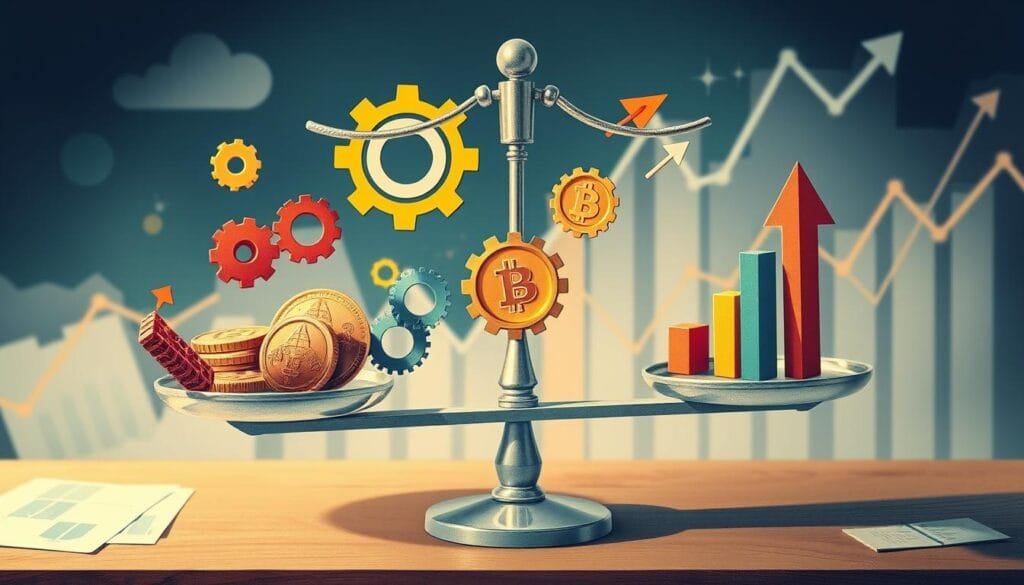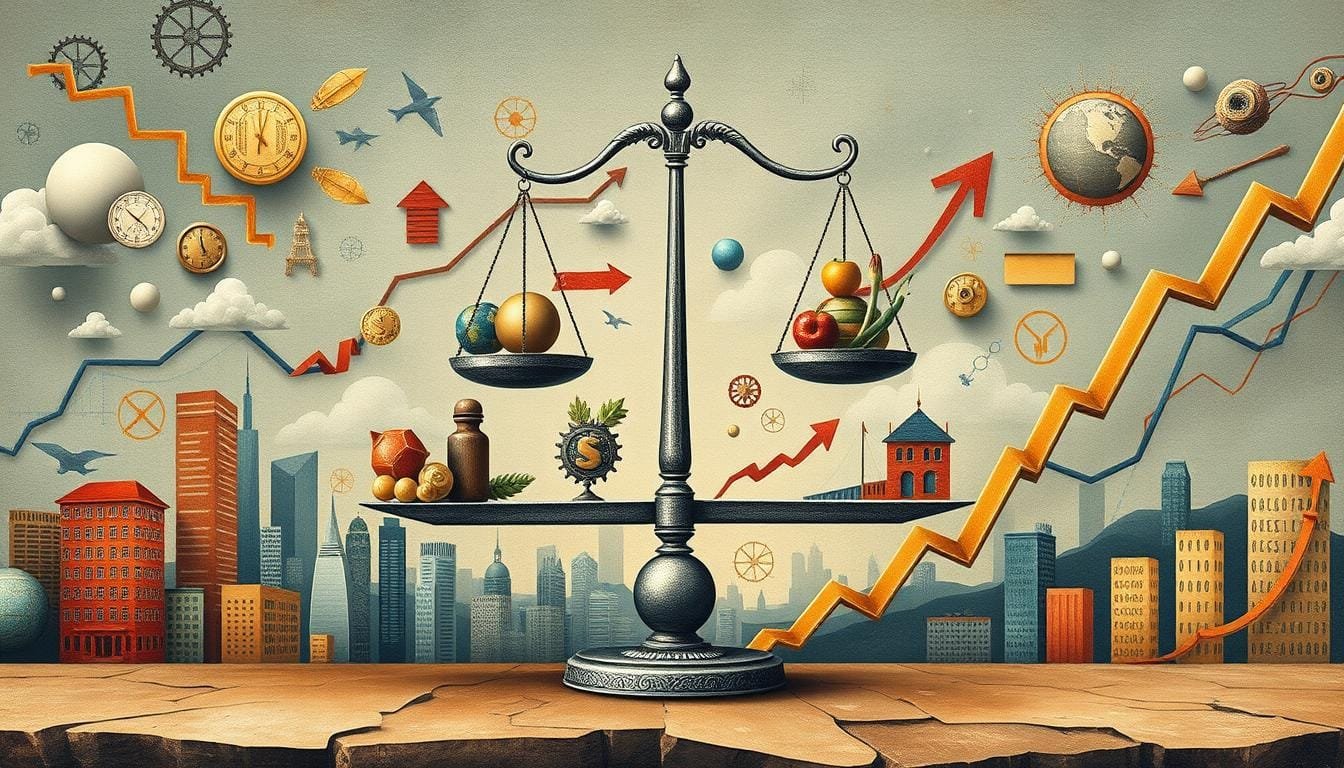Have you ever wondered why we can’t have everything we desire, regardless of our wealth or resources?
In economics, trade-offs are a key concept for making choices that involve sacrifices. Trade-offs help us understand the crucial decisions we make because resources are always limited. This idea is not just for big business or government decisions. It’s part of our daily lives and the personal choices we make.
By knowing more about economic decision-making and how to allocate resources, we can use what we have better. This helps us deal with the complex economic challenges we face every day.
Key Takeaways
- Trade-offs are decisions necessitating the sacrifice of one thing to achieve another, linked closely with opportunity costs.
- Daily choices, such as balancing physical activity and time, demonstrate trade-offs’ impact on personal resource allocation.
- The “guns versus butter” model highlights the trade-off in resource allocation between different types of goods.
- Understanding trade-offs aids in making more informed decisions, essential for personal and societal economic stability.
- Effective trade-off evaluation incorporates immediate and broader implications including environmental and social factors.
- Specialization and comparative advantage principles underline efficiency in production and trade.
- The balance between consumer and producer goods impacts a country’s economic growth and sustainability.
What is Trade-off in Economics?
Understanding trade-offs is essential in economics. It’s about choosing one thing and giving up another option. This idea is key in making choices when resources are limited. We’ll look at what trade-offs mean in economics and how they play into our everyday decisions.
Definition of Trade-offs
Trade-offs mean picking one alternative over others when resources are scarce. Consumers, businesses, and governments face these choices in how to use their funds. These choices focus on reaching some goals while letting go of others, influencing the economy’s direction.
Examples of Trade-offs in Daily Life
Trade-offs happen all around us. For example, imagine having $12 to spend with various items to buy:
- Bowling: $4.00
- Toys: $4.00
- Restaurant (lunch): $2.00
- Amusement Arcade: $5.00
- Candy: $1.00
- Movies: $5.00
With only $12, people can’t purchase everything. This requirement to choose shows how preferences and budgets guide our daily decisions. It’s like the decisions we face in the real economy.
Our choices include more than just shopping. For instance, the 2010 Eyjafjallajökull eruption closed airspace in 20 countries, stranding millions. This event shows large-scale trade-offs and how unexpected events affect economies. Similarly, the pandemic made people weigh the risk of infection against the benefits of activities, showing the complexity of economic decisions.
The Causes of Trade-offs
Trade-offs are a key part of economics. They happen because we want more than we can get. This is because resources are limited but wants are endless. Making choices in economy involves balancing desires with what is actually possible.
Unlimited Wants vs. Limited Resources
One main idea in economics is that our wants never end. Since we can’t buy everything, we must choose what we need most. For example, a country must decide between spending on defense or consumer goods, but it can’t fully afford both.
Increased economic output can lead to pollution and higher greenhouse gas emissions. Choosing to use farmland for biofuel rather than food can make wheat prices go up for everyone.

Economic Agent Decisions
Economic decisions involve trade-offs, whether by individuals, businesses, or governments. Consumers pick the best option available to them. For instance, spending on healthcare affects how much is left for defense and education.
- Auto companies choose between making 2 motorcycles or 1 car.
- Workers decide between further education or starting their jobs sooner.
- Governments weigh the choices between defense spending and consumer goods.
The idea of scarcity is shown by the production possibility curves (PPC). Changing resource allocation affects output. This shows the tough choices needed in managing resources. The balance between being efficient and fair often leads to debates, especially when it comes to income inequality.
| Scenario | Trade-Off Instances |
|---|---|
| Work vs. Leisure | Missing out on 10 hours of work means losing income |
| Economic Efficiency vs. Social Equity | More income distribution can lower economic production |
| Auto Production Choices | Choosing between producing 2 Motorcycles or 1 Car |
| Government Spending | Allocating $30 billion to health affects defense and education spending |
Importance of Understanding Trade-offs
Understanding trade-offs is key for everyone, from shoppers to businesses. Knowing what you give up helps make better choices. This can lead to better actions in the market, better economic results, and happier people.

Consumer Decisions
Trade-offs are a big deal in consumer choice. Picking between a high-end laptop and a cheaper one involves balance. People consider what they gain against what they save. Deciding to go to medical school is another example. It comes with an opportunity cost, including $30,000 a year in tuition and lost earnings of $50,000 a year. So the total cost before earning as a doctor reaches $260,000.
Worker Trade-offs
Workers face choices about their jobs and private life too. Working more hours means more money but less free time. This affects their happiness. Athletes make similar choices, focusing on different muscles for their sport. Like them, workers find a balance for their best performance.
Firm Decisions
Businesses also have to make choices about where to use their resources. For instance, they decide between spending on making things or on new ideas. Putting money into new ideas may help them stay ahead in the long run. In the car industry, companies choose between making big or small cars. Bigger cars are safer and roomier but use more gas. Small cars, like the Smart Car, are better on gas but can’t carry as many people.
Knowing about these trade-offs helps businesses move forward wisely. Following advice from RealEcon, firms can decide what matches their goals.
Trade-offs vs Opportunity Costs
Understanding trade-offs and opportunity costs is key in economic decisions. These terms are different and crucial for making choices. Knowing the difference helps us use our resources better.

Key Differences
Trade-offs require choosing between options, each with advantages and disadvantages. For example, a coffee shop may decide whether to install sprinklers. This decision could affect prices and customer demand. On the other hand, opportunity cost is about what you give up when you choose something. For instance, using $100,000 for product improvements instead of marketing. The missed chance to earn from marketing is the opportunity cost.
Examples Illustrating the Distinction
Let’s look at a student working 15 hours a week. The trade-off is between earning and studying. The opportunity cost is what they lose in grades by working instead. Buying a $40 video game presents another scenario. The trade-off is between the game and other purchases like clothes or savings. The game’s opportunity cost is the value of what wasn’t bought with that money.
Businesses face their own trade-offs. In 2023, U.S. firms dealt with significant decisions impacting jobs, especially in retail and manufacturing. Choosing between automation and expanding the workforce reflects on long-term growth versus short-term savings. Here, the opportunity cost is the value of the option not chosen.
| Scenario | Trade-off | Opportunity Cost |
|---|---|---|
| Business Capital Allocation | Product Enhancement vs. Marketing | Lost revenue from unchosen alternative |
| Student’s Schedule | Working vs. Studying | Potential academic performance loss |
| Consumer Purchase (Video Game) | Game vs. Other Items (Clothing/Savings) | Specific value of clothing or savings forgone |
| High-Cost Sneakers | Sneakers vs. Other Necessities | Restricted spending in other areas |
Grasping opportunity cost and trade-off concepts is vital in economics. It helps us carefully compare our choices. By considering what we miss out on, we can make better economic decisions.
Common Trade-offs in Economics
Trade-offs are key to understanding economics. They involve deciding how to use limited resources to meet various needs and desires. The “guns vs. butter” model is often used to explain this.
Guns vs. Butter
The “guns vs. butter” model shows how governments must choose. They can spend on military (guns) or on goods for people (butter). More military spending can improve safety but may reduce the quality of life by cutting goods and services. This choice highlights how putting resources in one area means having less for another.
Macroeconomic Trade-offs
In macroeconomics, countries must decide between spending on consumption or investment. The production possibility frontier (PPF) shows this. It means more capital goods production lowers consumer goods output, and the other way around.
For example, investing in infrastructure or healthcare might mean less consumer goods now. But, it aims for better long-term growth. These choices are vital for policies that balance now versus later.
Microeconomic Trade-offs
Trade-offs also appear in daily business and personal choices. Businesses make strategic choices weighing the benefits against the costs. Around 70% of these choices involve trade-offs affecting profits and efficiency.
For people, deciding whether to spend on fun or save for later is a common trade-off. These choices affect one’s economic health.
Trade-offs in International Trade
In the world of international trade, countries face tough choices. They decide what to export or import based on what they can produce best. This is important for making the most out of a country’s resources and keeping up in the global market.
The idea of comparative advantage is key to making these decisions. It means countries focus on producing goods at a lower cost than others. For example, the U.S. uses this strategy to stay strong in the global economy.
But, global trade-offs also bring challenges. The U.S. faces new barriers from other countries, under stricter trade policies. Nearly half of U.S. exporters are hit by these obstacles. This could even lower the U.S.’s GDP.
Policies like America First aim to protect key industries. Yet, they don’t always help the U.S. economy grow. One issue is finding the right balance between protecting industries and enjoying the perks of free trade. This could even affect the U.S. dollar’s global standing.
After the 2008 crisis, Americans are hesitant about new trade agreements. Adapting to Globalization 2.0 could be a way forward. It calls for market changes that meet today’s needs.
Alternatively, the Alliance Economics approach focuses on building stronger ties with allies. It’s about committing to international deals and improving trade. The world of international trade is all about balancing different goals. It involves national interests, market trends, and smart trade-offs.
Methods for Evaluating Trade-offs
To effectively assess economic trade-offs, robust decision-making is crucial. Analyzing data and outcomes helps ensure our choices bring the most benefit in the long run.
Tips for Improving Decision-Making
Effective decision-making includes several key steps:
- Thorough Analysis: We must collect and review all relevant data to grasp the effects of our decisions.
- Long-term Consideration: Choosing long-term benefits over quick wins is important.
- Flexibility: It’s crucial to adapt strategies to changes in the market or operations.
This method clarifies the consequences of each choice. The 2008 financial crisis showed the need to consider broader societal impacts in corporate decisions.
Strategic and Small-Scale Trade-offs
Trade-offs happen in both grand strategies and everyday operations. Strategic planning shapes a company’s future, like weighing ethical production against lower costs. Nike’s effort to better factory conditions, despite higher costs, is a strategic trade-off for ethicalness versus efficiency.
On a smaller scale, managing day-to-day tasks also presents trade-offs with more immediate impacts. Levi Strauss & Co. worked to improve workplace conditions to decrease workforce turnover. This shows the significance of each small decision.
These strategies highlight the value of strategic planning and solid decision-making in business. By using these techniques, companies can handle trade-offs well. This ensures decisions support broader economic objectives.
Conclusion
As we conclude our study on economic trade-offs, it’s obvious how crucial it is to know about these concepts. This knowledge is key for smart decision-making. From managing personal budgets to making policy decisions, the skill to balance trade-offs greatly improves results.
Trade-offs have a big impact in many areas. They show the real challenge of limited resources against endless desires. Through examining their causes, importance, and how to evaluate them, we’ve shed light on economic theories that guide important decisions.
For example, companies need to find the right mix of debt and equity financing. This tricky balance helps increase a company’s value while keeping costs low. It highlights why understanding trade-offs is essential for any strategy.
In short, managing trade-offs well leads to better use of resources, economic growth, and progress. Applying these ideas means we can make choices that push forward development. Concepts like opportunity cost teach us the importance of making informed choices. They are crucial for personal and wider economic situations. By grasping these economic principles, we can make smarter choices in a complicated world.
FAQ
What are trade-offs in economics?
In economics, trade-offs mean choosing one thing over another because resources are not unlimited. It’s about making the best decision with what you have. It’s key for wise and efficient decisions.
Can you give examples of trade-offs in daily life?
Sure, everyday trade-offs include choosing between saving or enjoying leisure activities. Also, companies must decide on focusing on research or hiring more people. These choices deeply affect both our personal finances and the economy.
Why do trade-offs occur?
Trade-offs happen because we want more than what we can have. Everyone, from single people to big governments, has to choose how to use their limited resources. It’s about giving up one thing to gain another, aiming to meet goals or needs.
How do trade-offs impact consumer decisions?
Trade-offs shape how consumers decide to spend their money, balancing between immediate desires and future needs. These decisions then affect how markets work and the overall economy.
What’s the difference between trade-offs and opportunity costs?
Trade-offs are about choosing between options. Opportunity costs are the benefits lost from the options not chosen. This difference helps us understand economic choices better.
What is the “guns vs. butter” model?
The “guns vs. butter” model shows how governments pick between defense spending and civilian goods. It highlights the balance between current consumption and long-term growth.
How do trade-offs affect international trade?
In international trade, countries decide what to export or import, based on what they’re best at producing. This makes the best use of national resources, improving their role in the global economy.
What methods can we use for evaluating trade-offs?
To evaluate trade-offs, we can analyze data and potential outcomes and think about long-term benefits versus short-term gains. Being flexible to change helps in making the best small and big economic choices.
